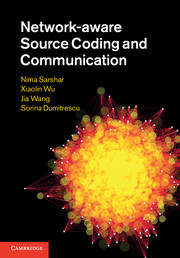Book contents
- Frontmatter
- Contents
- 1 Introduction
- Part I The lossless scenario
- Part II The lossy scenario
- 5 Lossy source communication: an approach based on multiple-description codes
- 6 Solving the rainbow network flow problem
- 7 Continuous rainbow network flow: rainbow network flow with unbounded delay
- 8 Practical methods for MDC design
- 9 Using progressive codes for lossy source communication
- 10 Lossy communication of multiple correlated sources
- References
- Index
7 - Continuous rainbow network flow: rainbow network flow with unbounded delay
from Part II - The lossy scenario
Published online by Cambridge University Press: 07 October 2011
- Frontmatter
- Contents
- 1 Introduction
- Part I The lossless scenario
- Part II The lossy scenario
- 5 Lossy source communication: an approach based on multiple-description codes
- 6 Solving the rainbow network flow problem
- 7 Continuous rainbow network flow: rainbow network flow with unbounded delay
- 8 Practical methods for MDC design
- 9 Using progressive codes for lossy source communication
- 10 Lossy communication of multiple correlated sources
- References
- Index
Summary
In Chapter 5, we introduced a practical approach to the NASCC problem by optimal diversity routing of MDC code streams (the RNF problem) and optimal design of the MDC codes by PET technique. There, we briefly discussed the role of the common rate of the descriptions r and the total number of possible descriptions K. The developments so far assumed communication with bounded delays, in which case the values of r, K become particularly important.
When the delay constraint is relaxed, we find that the set of all achievable distortion tuples converges to a limit independent of the description rate r. This limiting region will turn out to have a simple representation by introduction of a new form of flow we call continuous Rainbow Network Flow, or co RNF, as opposed to the discrete version of the problem considered so far in the thesis. co RNF can be viewed as the generalization of the RNF to fractional flows and is the subject of Sections 7.1 and 7.2.
In di RNF, we assumed the existence of K descriptions of equal rate r. co RNF, in one view, relaxes the constraint on description rates and allows for an arbitrary number of descriptions. Therefore, co RNF contains RNF as a special case. On the converse side, we show that the performance achievable with arbitrary description rates can be achieved, arbitrarily closely, using any description rate, provided that the delay constraint is relaxed and the number of descriptions is left unbounded.
- Type
- Chapter
- Information
- Network-aware Source Coding and Communication , pp. 71 - 81Publisher: Cambridge University PressPrint publication year: 2011



